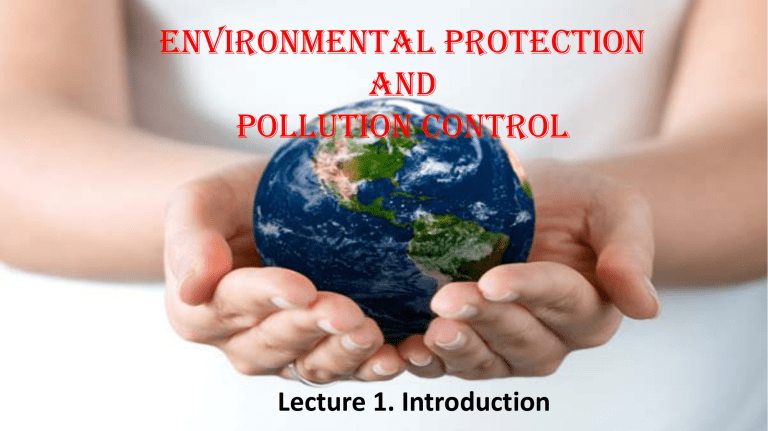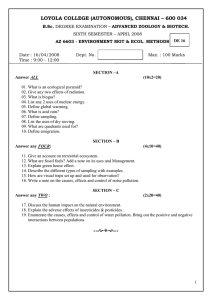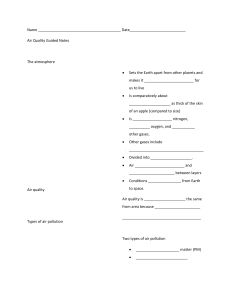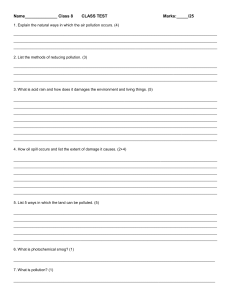Environmental Protection & Pollution Control Presentation
advertisement

ENVIRONMENTAL PROTECTION AND POLLUTION CONTROL Lecture 1. Introduction Environmental Engineering • It is the application of science and engineering principles to minimize the adverse effects of human activity on the environment Although it is impossible to eliminate negative impacts, human effects can be diminished and brought under control through….. • Public education • Conservation • Regulation • The application of good engineering practice Factors Affecting the Environment 1. Increasing number of humans on earth (population growth) 2. The rising standard of living (advances in agriculture, urbanization, industrialization) 3. Other human Activities List of Environmental Issues 1. Population 2. Climate Change 3. Loss of Biodiversity 4. The Phosphorus and Nitrogen Cycles 5. Water 6. Ocean Acidification 7. Pollution 8. Ozone Depletion 9. Over Fishing 10. Deforestation Ecological Impact on Environment On the productivity of the ecosystem (green plants, atmospheric oxygen) On other organism (microorganism, insects, animals) On climate (global warming, ozone hole, acid rain) Health Impact • Due to microbiological pollution • Due to microchemical pollution ENVIRONMENTAL PROTECTION AND POLLUTION CONTROL Lecture 2. Air Pollution Spheres of Earth All the rocks on Earth make up the rigid sphere of Earth known as the lithosphere. Earth and its surrounding Earth has 4 major connected systems a. Biosphere b. Hydrosphere- all of Earth’s water, ice, water vapor c. Atmosphere- the air blanketing Earth’s solid and liquid surface d. Geosphere- features of Earth’s surface (continents, rocks, sea floor, and everything below Earth’s surface THE BIOSPHERE Condensation Evaporation The biosphere is the portion of the Earth that is inhabited by life Precipitation Transpiration Runoff Seepage Root uptake Biosphere- part of Earth where life exists a. Includes all living and non-living parts b. Biota- collection of just living things in biosphere Type of Biotic Hydrologic Cycle The Nutrient Cycles The Carbon cycle CO2 in atmosphere CO2 in Ocean The Nutrient Cycle The Nitrogen cycle N2 in atmosphere NH3 NO2- and NO3- The Nutrient Cycle The Sulphur cycle & The Phosphorus Cycle World Population growth World Population growth Environmental Trends Environmental Trends Table: Decline in selected animal and species Pollution of Air, Water and Soil 1. Impact of coal mining 2. Fossil fuel related pollutants in environment 3. Carbon emission and global warming 4. Reduction in carbon Emissions 5. Impact of urban area 6. Environmental impact of hydro-electric and Nuclear energy Pollution of Air, Water and Soil 7. Chemical Pollution 8. Marine Pollution 9. Solid wastes 10. Ozone Depletion Unit 1: Air pollution: Sources and its effects Cont… Cont… Classification and its properties of Air Pollutants Classification Primary pollutants (PM, SOx, NOx, CO, Hydrocarbon) Secondary pollutants (SO3, PAN, Aldehydes, Ketones, Ozone) Primary Air Pollutants Properties of Air Pollutants Particulate Matter (PM) Size: 100μm – 0.1μm and less Dust: 1 – 200 μm Smoke: 0.01 – 1 μm Fume: 0.1 – 1 μm Mist: smaller than 10 μm Aerosol: smaller than 1 μm Size of PM Primary Air Pollutants Oxide of Sulphur Nitrogen Oxides Carbon monoxide Hydrocarbons Emission Sources Cont… Importance of Anthropogenic sources Emission Sources in India Behavior and fate of air pollutants Particulates: (a) Wet removal by precipitation (b) Dry removal by sedimentation, impaction and diffusion Gases: (a) Wet removal by precipitation (b) Chemical reaction in the atmosphere to produce aerosol and/or (c) Absorption or reaction at land and ocean surfaces. Interaction of pollutant at Earth surface Photochemical smog Effect of Air pollution Human health Cont… Human health Cont… Respiratory Effects Air Pollution laws and standards Role of Pollution Control Board Indian ambient air quality standards Metrological Aspects for Air pollutant Dispersion Lecture 3. Metrological Aspects for Air pollutant Dispersion Atmospheric stability Temperature Lapse rate- decrease of temperature with height: Γ = - dT/dz Moist Environmental lapse rate (Γ) order 6 ºC/km in free atmosphere Dry adiabatic lapse rate (Γd)- rate at which an unsaturated parcel cools when lifted (Γd ) = 9.8 ºC/km Saturated adiabatic lapse rate (Γs) - rate at which a saturated parcel cools when lifted (Γs) = 4 - 9.8 ºC/km Remember: Dry > Moist always Cont… Adiabatic lapse rate Cont… Adiabatic lapse rate Atmospheric stability Atmospheric stability Atmospheric stability Environmental lapse rate Plume behaviour (Looping) (Coning) Near about natural conditions but wind velocity > 32km/h (Natural) (Fanning) Plume behaviour (Lofting) Stack Height Effective Stack Height Air Pollution Sampling and Measurement Air quality monitoring Sampling and measurement of air pollutants generally known, as air quality monitoring. It is an integral component of any air pollution control programme. Why monitoring is important? 1. Air quality can be evaluated 2. Information is helpful in implementing control measures for reducing pollutant concentration to acceptable levels 3. Assessing the effect of air pollution control strategies. Air sampling Classification of sampling methods: Sampling of impurities of every nature (Ranging from particulate matter to gases) Sampling under various environmental conditions (ranging from samples taken from chimneys to samples taken in the open air) Sampling methods varying according to the time factor (Ranging from intermittent to continuous sampling) Air Quality measurement is undertaken in two situations: Ambient air quality measurement Stack monitoring Air sampling Ambient air quality measurement: Where the pollutant levels in the ambient atmosphere are measured. Stack sampling: It deals with the pollutants emitted from a source such as smoke stack and is known as stack sampling. It provides information on the nature and quantities of various pollutants that are emitted into the atmosphere.






